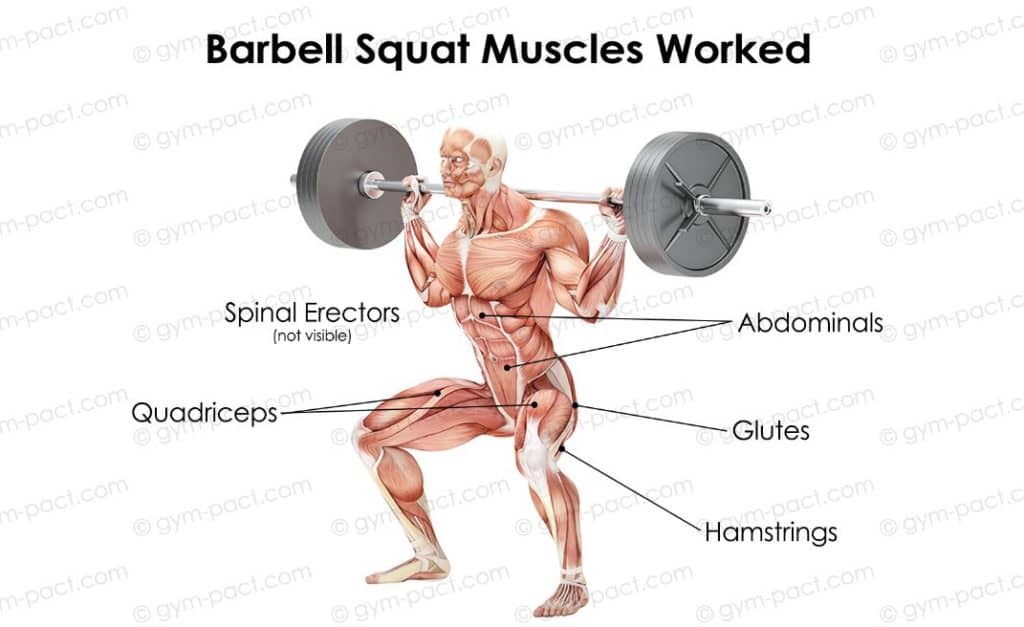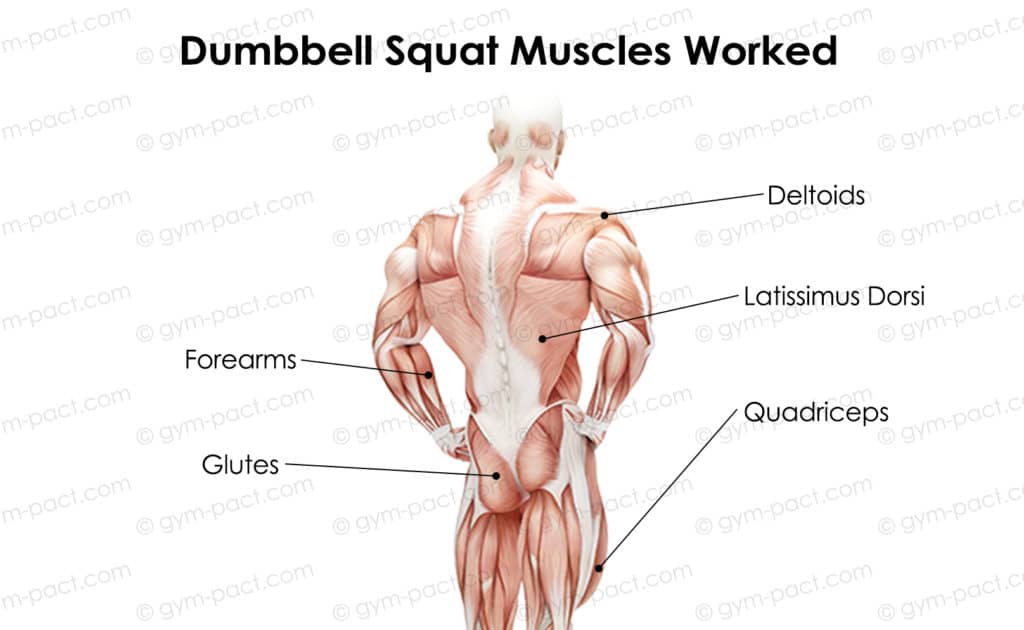The barbell squat is, rightly or wrongly, the king of weight training exercises. For bodybuilders around the world, it has achieved legendary status as a quad developer. As a result, if your leg routine doesn’t include the barbell squat, you are likely to be ridiculed and derided.
But does the barbell squat actually deserve its reputation as the best thing you can do short of quadricep implants to get big legs?
In this article, we challenge the superiority of the barbell squat by putting it head to head with the dumbbell squat. We’ll discover, once and for all, whether the barbell squat is the best version to perform or whether you’re better off ditching the bar and grabbing a pair of dumbbells.
Barbell Squats: How to, Muscles Worked, Range of Motion, Benefits, Drawbacks & Variations
How To Do It
- Stand in front of a squat rack with a loaded Olympic bar on it.
- Place the bar high on your trapezius and space your feet shoulder-width apart, the toes pointed slightly outward.
- Bend the knees to descend into the squat until the tops of the thighs are below parallel. Straighten the legs to return to the starting position.
Muscles Activated and Range of Motion

The barbell bar squat primarily works the quadriceps, glutes, and hamstrings. There is also an element of core bracing involved which helps to strengthen the abdominals and the spinal erectors. The barbell bar squat allows you to move through a full range of motion in terms of descending into a full squat and then coming back to a standing position.
Benefits of Barbell Squats
1. Glute Strength
Your glutes are the largest muscle group in your body. Barbell squats will allow you to engage and activate your glutes.
2. Quadriceps Strength & Size
Squats will strengthen all four of your quadriceps muscles – the vastus medialis, vastus lateralis, vastus intermedius, and rectus femoris. These muscles are designed to facilitate leg extension and to support knee bend. Squatting activates each of them. The muscular overload that you can achieve with squats, will allow you to place stress on the muscle fibers that leads to muscle growth.
3. Jumping Ability
When you perform full squats, you will enhance your vertical jumping ability. According to a 2012 study that involved 59 athletes, a 10-week program of progressive resistance back squats significantly increased vertical jumping ability.
4. Greater Mobility
When you perform the barbell squat, you are moving your body through a range of different planes of motion. You also learn to perform the hip hinge movement which is crucial to more functional movement. The greater strength that you develop from squatting will also help to improve your mobility, with strong glutes being especially important.
5. Enhanced Hormone Release
The barbell squat has been shown in numerous studies to have the ability to boost the body’s natural production of the two key anabolic muscle-building hormones – testosterone and human growth hormone.
Researchers believe that the key driver of this enhanced anabolic hormone release is the acute stress that is demanded from the body when you perform the barbell back squat.
Drawbacks / Limitations of Barbell Squats
1. Spinal Load
The natural curvature of a healthy spine is severely compromised when you load a heavy weight on your back. It increases the natural curvature of the spine.
This, in turn, squeezes and distorts the intervertebral discs. When you load 300 pounds on your spine week after week, you are giving your back some serious issues, including spinal disc damage.
2. Quad Activation
The lower leg (tibia) is the lever that operates the quads. The upper leg (femur) operated the glutes. Unless those levers move, the muscles that they operate will not be sufficiently activated.
When you descend into the squat, the lower leg moves to a maximum angle of around 30 degrees. That means that the quads will be activated to a load of 30 percent of the weight on the bar.
What that means is that the barbell squat is loading 70 percent of the weight on the bar, and therefore compromising your spinal integrity, with absolutely no benefit to either your quadriceps strength or muscular development.
Barbell Squat Variations
1. Cable Squats
Cable squats are a variation of the back squat that eliminates the spinal compression problem. It also allows you to lean back when you are squatting which means that you are able to achieve a greater than 30-degree angle through the tibia.
How to Do It
- Set a cable pulley machine to its lowest setting and stand facing the machine facing it. Grab the handles and stand a few back from the machine, leaning back.
- Descend down into a parallel squat, maintaining a backward lean throughout the movement.
2. Resistance Band Squat
The resistance band squat is a great at-home version of the back squat that allows you to place a load on your upper legs without the risks on the spine involved in the back squat.
How To Do It
- Stand with your feet shoulder width apart and a loop band under your mid feet. Have the other end of the band over your shoulders and your hands crossed at shoulder level with your elbows up.
- Descend down into a parallel squat.
- Push through the heels to return to the start position.
3. Pistol Squats
Pistol squats are a back squat variation that can be done without any equipment. This is a challenging exercise that allows you to work each limb unilaterally. This is the most difficult form of bodyweight squats.
How To Do It
- Stand upright with your feet shoulder width apart.
- Raise one leg in front of your body as you push your hips backward and flex the standing leg into a squat. Yu can allow tour arms to go out to the sides or in front of you to help with your balance.
- Lower the hips as far as possible while keeping the front leg lifted.
- Push back up to the starting position.
Dumbbell Squats: How to, Muscles Worked, Range of Motion, Benefits, Drawbacks & Variations
How To Do It
- Stand with your feet shoulder width apart with your feet pointed slightly outward. Hold a air of dumbbells at arm’s length at your sides.
- Bend the knees to descend into the squat until the tops of the thighs are below parallel. Straighten the legs to return to the starting position.
Muscles Activated and Range of Motion

The dumbbell squat is a variation of the barbell bar squat that allows you to provide a similar load in the quads and glutes as the barbell version of the exercise without loading the spine.
This version of the exercise will work the quadriceps, and glutes just as the back squat does.
However, the fact that you are holding the weights in your hands means that you will also be activating the muscles in your deltoids, latissimus dorsi, and forearm muscles.
Benefits of Dumbbell Squats
1. No Spinal Load
The biggest advantage that the dumbbell version has over the barbell back squat is that you are not creating spinal compression. The lack of load on the back means that you will not have to deal with spinal disc damage.
2. Core Activation
With the weights at your sides, you will experience greater core activation with dumbbell squats than back squats. That’s because there is greater balance and stability required in controlling the dumbbells. That brings into play the body’s stabilizer muscles.
3. Grip Strength
Your grip and forearm strength will improve as a result of holding heavy dumbbells as you perform this exercise.
4. Safety
The dumbbell version of the squat is safer than the back squat if you get stuck while performing the exercise. If you are unable to rise out of the squat hole, you simply let the weights go and they drop harmlessly to the floor alongside you. When you get stuck during a back squat, however, you had better have either a spotter or a power rack handy – or else!
5. Unilateral Training
Squats with dumbbells allow you to engage in unilateral training. Working each limb independently has been shown to provide greater results in terms of both muscle and strength development.
Drawbacks / Limitations of Dumbbell Squats
1. Weight Limitations
The biggest drawback of the dumbbell squat compared to the back version of the exercise is that you are not able to use it as a heavy weight. That’s because you are limited to the weight of the heaviest dumbbells you can grab and hold onto for the number of reps that you will be performing.
Most people will find that their grip will fatigue before their quads and glutes do. As a result, they will not be able to work their legs as intensely as they would on a back squat.
2. Quad Involvement
The same problem that was pointed out regarding the back squat’s inability to move the tibia beyond 30 degrees also applies to the dumbbell squat. As a result, you will only be getting 30 percent of the actual load that you are holding.
So, if you are able to hang on to 100-pound dumbbell squats, the load on each of your quads is only 30 pounds. Couple this with the fact that you are not able to use as a heavy weight on this version of the exercise and it’s pretty clear that your quads are not going to get fully stimulated on this exercise.
Dumbbell Squat Variations
1. Kettlebell Squats
The kettlebell or goblet squat is very similar to dumbbell squats except that they allow you to hold a single kettlebell in front of your body. Many people find this a more comfortable position. It also allows some people to lift more weight than they would when holding dumbbells as the forearms are no longer the limiting factor in the exercise.
How to Do It
- Stand with feet shoulder width apart and a kettlebell held by its ring at chest level.
- Hinge at the hips to descend down into a parallel squat.
- Push through the heels to return to the start position.
2. Band Sumo Squat
The band sumo squat allows you to get an effective leg workout in at home even if you don’t have access to barbells or dumbbells. With an inexpensive resistance band, you can blast your quads and glutes with this wide version of the squat movement.
How To Do It
- Stand with your feet about six inches wider than shoulder width apart. Place a resistance band under your mid feet and hold the other ends of the band at shoulder level with palms facing forward.
- Descend down into a full squat.
- From the bottom squat position, push through the heels to return to the start position. Maintain an upright position throughout the exercise.
3. Step Ups
Step Ups is a bodyweight exercise that activates the same lower body muscles that are worked during the dumbbell squat. You can also engage the forearms, front delts, and lats by holding dumbbells in your hands.
How To Do It
- Stand in front of a step or box that is between 16 and 24 inches in height.
- Step up onto the box with your right foot.
- Follow through to bring your left foot up on the box.
- Reverse direction with your right and then your left foot to return to the start position. Perform your reps in a fast, fluid motion and maintain an upright position throughout the exercise.
Barbell Squat vs Dumbbell Squat: Which Should You Choose?
Now that we’ve taken a close look at each of these exercises, what conclusion should we come to? If you are wanting to push as much weight as you possibly can to achieve maximum strength, then the barbell bar squat is definitely the way to go.
As a result of being able to squat with a heavier weight, you will also be able to potentially build greater strength and muscle mass with the barbell squat as opposed to the dumbbell version of the exercise.
So, a key advantage of barbell squats is that it is a better overall body strength exercise.
On the other hand, if you are more concerned about the safety of your spine than the amount of weight you can move up and down with, you should opt for the dumbbell version of this exercise.
The leg extension is a more biomechanically sound and effective quad engager than either version of the squat so you do not have to go heavy with a weight on your back to build size in your upper legs.
Another advantage over barbell squats that you get with dumbbell squats is that they allow you to more effectively correct muscle imbalances. In addition, they provide the benefits of unilateral exercise. You will also get a strong core faster when you do dumbbell squats.
The safety of the dumbbell version of the squat is another benefit of dumbbell squats. Getting out of trouble on this exercise is as simple as dropping the weights.
The dumbbell squat is also a more user-friendly exercise, requiring less setup and less equipment. There are also more variations to the dumbbell version of the squat than the barbell version. These include the dumbbell split squat, the Bulgarian split squat and the dumbbell front squat.
The dumbbell squat will also work the forearm muscles more than barbell squats.
Conclusion
In a head-to-head between Barbell Squats & Dumbbell squats, the dumbbell version of the squat gets the nod as the safest, most versatile, and most user-friendly version of the squat.
You won’t be able to squat as heavy as you could on the barbell back squat, but, if you combine your dumbbell squats with leg extensions and cable squats, you will get a more effective lower body workout.
Frequently Asked Questions
How much weight should I squat with dumbbells?
If you are doing dumbbell squats to build quad size and strength, you should start with a weight that allows for 15 reps. Then add weight and decrease the reps on succeeding sets until you are performing 6 reps with your heaviest weight.
Do squats make your butt bigger?
Squats work the glute, or butt, muscles. So, if you are doing squats with progressive overload, then you will strengthen and develop the butt muscles.
Do dumbbells build more muscles than barbells?
On some exercises, dumbbells will provide a more effective way to work your muscles that barbells. The limiting factor on a barbell is that your hands are locked in position, preventing you from coming together. This stops you from getting a full range of motion on some exercises. An example is the bench press. When you use a pair of dumbbells, you can bring your hands together to fully contract the pectoral muscles.







